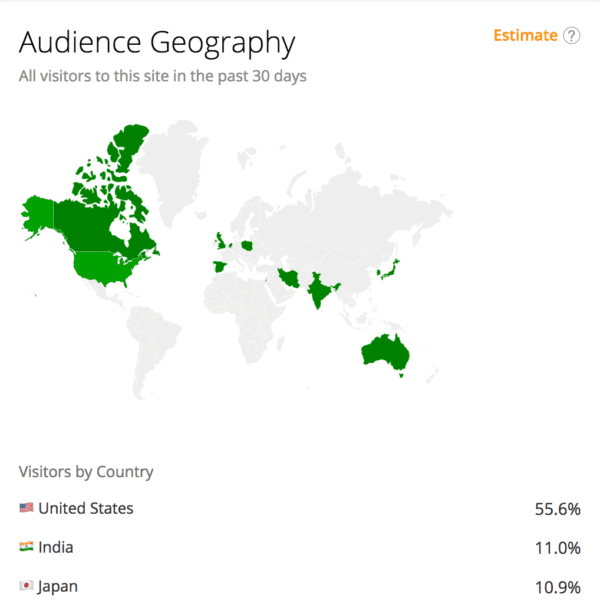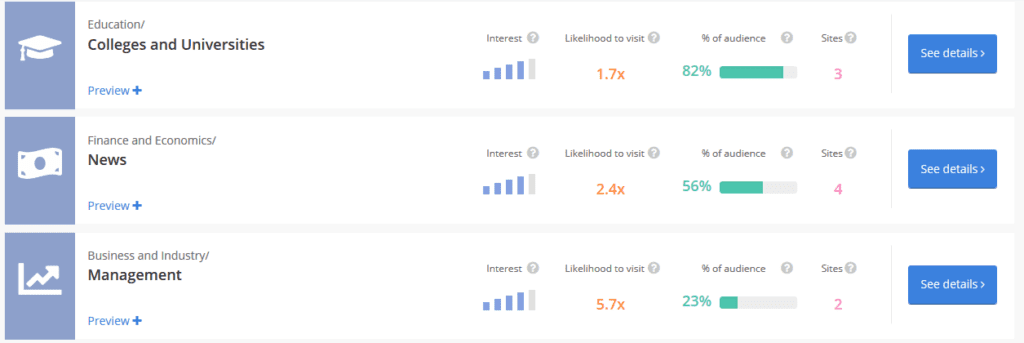Improving competitiveness and achieving business goals are constant pursuits regardless of the size or sector of the business. For this, it is essential to develop a correct market segmentation.
To achieve their goals, organizations need to establish a series of strategies that guarantee customer satisfaction. First, however, there is an essential preliminary step for any business: confirming its customers and the target market’s characteristics.
What's in this article:
What characteristics should a market segment have?
Before seeing the different types of market segmentation that exist, we must consider a series of characteristics that must be fulfilled.
Measurable.
We must be able to measure the size of each of the segments; otherwise, we will not be able to determine how many people we are addressing. We should also be able to analyze the purchasing power and the different characteristics of each profile.
Accessible.
It is useless to identify a profitable segment if we are not going to have the necessary resources to serve it effectively.
Substantial.
Market segments must also be large enough to be profitable.
Actionable.
In other words, we can create a marketing strategy that allows us to “attack” each of the segments.
What is market segmentation?
The definition of market segmentation could be understood as dividing the market into smaller groups that share common characteristics.
And also, based on these differences, each group may need differentiated products or marketing strategies.
These groups can also be called segments.
To divide the market, we will do it based on objective and/or objective criteria (also called market segmentation criteria ).
Market segmentation makes it possible to structure the total market into smaller and more homogeneous groups with similar characteristics, needs, or habits.
What is the difference between target market and market segment?
What segmentation does is divide a cake into different pieces, while the target market will be the part of the cake that we will eat.
To clarify the concept, I will explain what the selection of target markets (target audience) consists of. It mainly consists of evaluating each market segment’s attractiveness and deciding how many of them the company will “attack.”
This decision will depend on the resources and capacities available to the company.
Objectives of market segmentation
If you’ve stopped to read the definition carefully, I think you can guess what the purpose of market segmentation is. The main objective is to segment the market to direct marketing actions to an audience with shared variables.
Let me give you an example so that you understand it better.
Imagine that you are thinking about running a Facebook Ads campaign, and you wonder how to segment your target audience. To do this, you will analyze the different segmentation variables to know your buyer persona’s tastes, interests, and motivations. You will then conclude that one of the segments of people most interested in your products has Star Wars as a common interest.
Therefore, if you create ads with specific Star Wars themes, you will increase the CTR of your ads by feeling more identified with your advertising.
This is what segmenting the market is for!
To form groups of people with shared interests and try to do more personalized marketing actions. Another objective of market segmentation would be to optimize the resources and capacities available to the company.
If we have limited financial resources to run advertising campaigns, we should optimize our ads to the maximum, right? And how do we do it?
By showing the right ad to the right people!
And for this, we must have previously analyzed them and know what elements some groups have in common with others.
What is segmenting the market in marketing?
To understand segmentation from a marketing perspective, you have to differentiate between two points of view. This is very important that you keep it in mind for one reason always.
For example, BMW’s marketing policy targeting young people with high spending power is different from the general communication it does. Instead, use a different product, a different price, and communication adapted to that segment.
So when we are going to segment the market, we will also have to adapt our marketing mix strategy.
What does this mean?
We will have to adapt the variables (Price, Product, Promotion, and Distribution) to the segment’s needs.
A) Segmentation from the point of view of demand.
Here we understand by market segment that a part of the market has one (or more) characteristics or attributes that differentiate it from the rest of the segments.
B) Segmentation from the point of view of supply.
While from the point of view of supply (that is, from the company side), market segmentation is a marketing strategy that allows for competitive advantages. It consists of identifying and locating those most attractive segments to the company (either by volume or by the positioning of the company itself) and attacking them.
Advantages of doing a market segmentation
If you are not yet applying segmentation in your company, I will give you a series of solid reasons why you should start doing it.
1) Identify the needs of your target audience
The main advantage of market segmentation is that it will better understand our target audience’s needs, desires, and motivations.
And this point is going to be related to all the ones that we will see below.
2) More personalized marketing strategies and actions
If we know our target audience well and know what their interests are, we will be able to carry out more personalized marketing actions, don’t you think? Remember the example I gave you before Star Wars.
If I identify a segment of my target audience that is a massive fan of this saga, don’t you think that if I speak to them with a specific language or make certain references to the films, they will feel much more identified with my brand?
3) Increase the sales of your company
If I can adjust the product, the price, and the communication to the real needs of my target audience, I will also be able to increase the profits of my company.
4) Reduce costs
If I identify the primary market niches that my company has to target and reject those that will not be profitable, won’t I be reducing costs?
5) Increase customer loyalty
If customers are more satisfied because you can better focus your resources and capabilities on them, it will be easier to retain them, right?
Segmentation of the different types of market
Market segmentation is divided into four types, each with different characteristics. To achieve better positioning, increase brand awareness and optimize resources, it is necessary to apply them all.
Demographic
It allows companies to know specific aspects of their audience. The more specific, the easier it will be to acquire leads. This segmentation’s variables include age, gender, marital status, sexual preferences, educational level, profession, socioeconomic level, housing, culture, and religion.
Geographic
It refers to the environment and the physical space in which the target audience operates. The following variables are taken into account: the country, state, city, region, and climate in which the audience is located.
With the growth of Internet consumers, this segmentation has less and less relevance since now the products are within reach of a smartphone. In addition, thanks to tech giants like Amazon, Mercado Libre, and eBay, brands now have an international presence more easily.
Psychographic
The most relevant segmentation, since it analyzes the behavior, needs, and preferences of consumers. Increasingly, audiences seek products that give them experiences or that align with their ideals. Its variables are personality, lifestyle, values, attitudes, and interests.
In this case, social networks and geomarketing become the most crucial tool for companies. By studying your audience, it is easier to develop advertising strategies that move their emotions.
Behavioral or behavioral
This segmentation shows users’ behavior and consumption patterns, their loyalty to the brand, sensitivity to price, the frequency or occasion of purchase, and the benefits they seek when choosing a product. With these data, it is easier to profile the good or service before launching it on the market.
With segmentation based on behavior, we are going to divide consumers based on the following variables:
- According to the moment of use
- According to the benefits sought
- Use level.
- According to the frequency of use
- According to the level of loyalty
- According to your disposition
- According to the attitude towards the product or the brand
We are going to see several examples of these variables to make them clearer for you.
Depending on the time of use, we will have to consider the type of purchase they make if it is a periodic, occasional, or special purchase.
Depending on the level of use, we will have to segment the market based on:
- Not consumers.
- Former consumers.
- Potential consumers.
- Regular consumers.
- Occasional consumers.
- First-time consumers.
Depending on the frequency level, we will have to differentiate between occasional, medium, and frequent use.
For example, we could give discounts to the most frequent consumers of our product. It is a practice that many restaurants use with their loyalty cards in which when you go X times the next dinner, you have it free.
Depending on the level of loyalty, it can be none, medium, strong or unconditional. Therefore, a brand needs to detect which are the most loyal consumers and reward them somehow. But also find out the reasons why they do not get the loyalty of other types of consumers.
Depending on their disposition, we should differentiate between those who do not know, know, are already informed, and intend to purchase.
Depending on the stage of purchase in which they are, we must make one type of content strategy or another.
Thanks to this segmentation, companies benefit from a series of advantages, including:
- The possibility of knowing better the peculiarities and needs of your clients or target consumers.
- It facilitates the design of a tailored, more specific, and effective marketing mix strategy.
- Increases the probability of satisfying the needs and tastes of customers.
- It allows companies to be more competitive and achieve better results.
Companies must consider that market segments are constantly changing, with different interests and approaches in each generation. One way to do it is to ask, know, join and anticipate trends since they can only survive. Moreover, unlike a few years ago, today’s products have regularity, making brands constantly innovate.
At the same time, the competition is overwhelming, so it is advisable to research and study the competitors. This way, it is easier to highlight the differentiating characteristic in the product, generating a competitive advantage.
When segmentation is done correctly, it is possible to offer products and services that interest the consumer and allow the best marketing and advertising strategies to be drawn up for the organization.



Leave a Reply
You must be logged in to post a comment.